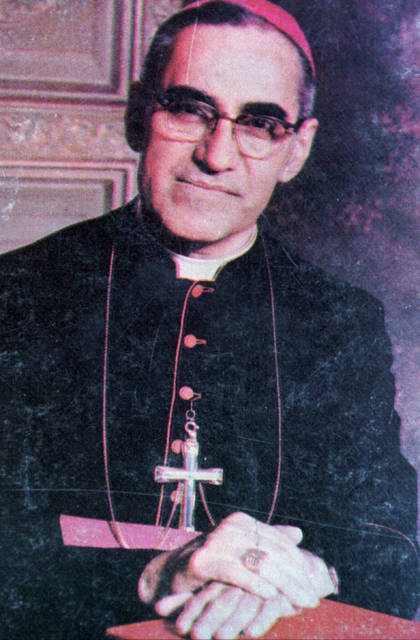VATICAN CITY — Pope Francis has cleared the way for Archbishop Oscar Romero to be made a saint, declaring that the churchman murdered by El Salvador’s right-wing death squads for standing up for the poor and oppressed should be a model for today’s church.
Francis signed a decree confirming a miracle attributed to Romero’s intercession on Tuesday, the same day he approved a miracle for another important figure for the 20th century Catholic Church, Pope Paul VI, the Vatican said Wednesday.
No date was set for either canonization. Vatican officials have previously said Paul VI would likely be canonized in October, during a big Vatican meeting of bishops.
The Vatican official who spearheaded Romero’s sainthood cause, Archbishop Vincenzo Paglia, said he hoped the two would be declared saints together in October, saying a joint canonization would give Catholics a “burst” of energy and example of the need to live one’s life for others.
“I’m in a hurry because there’s an urgent need to change the world,” Paglia told The Associated Press.
Another option would be to canonize Romero closer to home, such as when Francis travels to Panama in January for World Youth Day. The big Catholic youth rally will unite tens of thousands of young Catholics from across Central and South America, where Romero is considered a hero.
Romero was gunned down by right-wing death squads on March 24, 1980, as he celebrated Mass in a hospital chapel. The country’s military dictatorship had vehemently opposed his preaching against the army’s repression of the poor at the start of the country’s 1980-1992 civil war.
News of his pending canonization was met with celebration in San Salvador, where President Salvador Sanchez Ceren tweeted that Francis’ decision “fills us with immense joy.”
Cardinal Gregorio Rosa Chavez, a close associate of Romero, called it “an answer from God to the outcry of a people who have suffered so much.”
Paglia said Romero’s example of literally paying with his life for the poorest of the poor was particularly needed today, “in a world full of individualism and oppression, where inequality grows rather than diminishes.”
Pope Benedict XVI unblocked Romero’s stalled sainthood case in December of 2012, and Francis pushed it through, declaring him a martyr for the faith in 2015.
The case had been held up for years by the Vatican, primarily due to opposition from conservative Latin American churchmen who feared Romero’s perceived association with liberation theology would embolden the movement that holds that Jesus’ teachings require followers to fight for social and economic justice.
St. John Paul II’s conservative Vatican had launched a crackdown on liberation theology, and the cause languished in the Vatican’s doctrine office while theologians studied his writings to ensure they were doctrinally sound. They were, and both Romero and theologians associated with the movement have been rehabilitated under Francis’ papacy.
“It has been a long, tortuous journey, full of obstacles and opposition,” Paglia said. “But it has finally reached its conclusion.”
In an interview at his Vatican home on Wednesday, as he fielded congratulatory calls from well-wishers in El Salvador, Paglia recalled that the Salvadoran vicar-general had given him Romero’s pectoral cross when he was named postulator for the cause some 30 years ago. It was to be a source of help and hope, Paglia said, because everyone involved knew opposition to the cause would be so fierce.
“In fact, they were right, because as soon as the cause from San Salvador arrived in Rome at the Congregation for the Causes of Saints, it was blocked,” Paglia said, fingering the gold cross that he now uses as his own. He credited Benedict, and later Francis with pushing it forward, noting that Francis spoke to him about the cause on March 19, 2013, the first official day of his pontificate.
Paglia said the miracle that cleared the way for Romero’s sainthood concerned the medically inexplicable cure of a pregnant, terminally ill Salvadoran woman who was “condemned to death” by illness but lived, and gave birth to a healthy child.
The woman’s husband first began praying to Romero on May 24, 2015, the day Romero was beatified in San Salvador, Paglia said. By late August or early September, the woman’s condition had worsened and her doctors delivered the child fearing that he too would die.
“They did the Caesarean and were waiting for her to die,” because all the tests indicated she wouldn’t survive. Paglia didn’t specify the illness. Her friends started praying to Romero “and after five days, in an inexplicable way, this woman begins to improve and was completely healed.”
Romero was beatified in San Salvador on May 24, 2015, before a quarter-million jubilant Salvadorans, and held up as model of peace and forgiveness for Francis’ home continent.
For Salvadoran churchgoer Josefa Trejos, the news of his pending canonization only confirmed what she had long believed.
“The pope is giving us a blessing with this news, but Saint Romero is already on the altars,” she said. “He is already miraculous and a saint.”
———
AP writer Marcos Aleman contributed from San Salvador, El Salvador.


